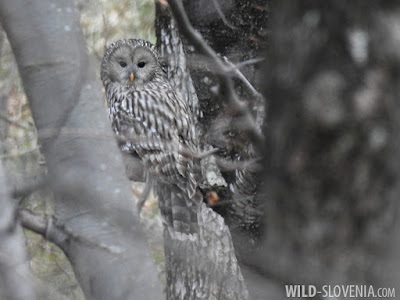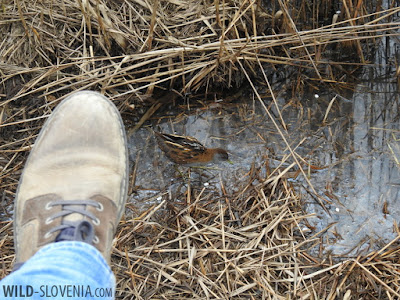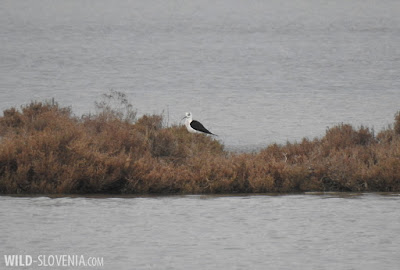
In recent weeks we've been quite busy with our traditional census of
Middle Spotted Woodpecker Dendrocopos medius in western Slovenia, particularly in the Karst. Since 2016 we've been carrying out the census with the standardised playback method, usually with the help of other DOPPS-BirdLife Slovenia's volunteers (who we sincerely thank!). This year we decided to repeat the census in some areas we first investigated in 2016, as well as try to discover new territories, especially in the Karst. Currently we still need to carry out some of the census transects, but we already covered most of the areas of interest during the past week. So far the census has been a major success, with at least one Middle Spot recorded on every transects, but higher numbers were usually the norm. We are particularly happy with the results from the Brkini hills, where two transects (with approx. 8 census points each) held 13-14 individuals, while a trasect in a large area of oak woodland in the western part of the Karst held 7 individuals. Therefore this year we discovered several new territories on previously unknown locations for the species. All in all it looks like the species is fairly common in the right habitat, but is probably also expanding its range westwards, year after year. For more about the species in western Slovenia
see here.

 |
| Middle Spotted Woodpecker Dendrocopos medius |
During the first day of the census and even before recording the first Middle Spot, we were taken by surprise by a large raptor that we flushed in the oak-beech forest. It was a beautiful Ural Owl Strix uralensis - probably one of the 3 individuals we've been observing in recent years as wintering and erratic birds in the wider area of this observation. As we had a census to carry on, we didn't have much time to follow the owl's movements, but when it disappeared in the trees, it even delivered us a few spontaneous notes of its song.
 |
| Ural Owl Strix uralensis |
Other forest wildlife was also to be enjoyed during the censuses. On one point we found a Black Woodpecker Dryocopus martius excavating a nest hole, while the usual 4 other woodpecker species were also commonly heard/seen. Interesting was the presence of some singing Treecreepers Certhia familiaris, sharing their territories with the commoner Short-toed Treecreepers Certhia brachydactyla. There aren't many areas in Slovenia where the two species live in the same habitat.
The forest flora was (and still is) on good show and the plants we enjoyed most were certainly Dog's-tooth Violets Erythronium dens-canis, covering the woodland floor in some areas. It was also nice to see year's first Hacquetias Hacquetia epipactis, one of Slovenia's most typical spring wildflowers.
 |
| Black Woodpecker Dryocopus martius excavating a nest-hole. |
 |
| Treecreeper Certhia familiaris |
 |
| Dog's-tooth Violet Erythronium dens-canis |
 |
| Hacquetia Hacquetia epipactis |
 |
| Mezereon Daphne mezereum |
 |
| Alpine Squill Scilla bifolia |
 |
| Spring Crocus Crocus vernus |
 |
| Spring Heath Erica carnea |
In an area of open meadows in the Brkini hills we also observed probably winter's last Great Grey Shrike Lanius excubitor and the year's first copper - a Small Copper Lycaena phlaeas.
Last weekend we also attended DOPPS' yearly
Eagle Owl census in the Karst and checked our traditional site, where male and female
Eagle Owl Bubo bubo were singing at dusk. We even saw the male perched on top of a black pine, similar to
last year's encounter. After nightfall a Tawny Owl
Strix aluco began to call and then an unexpected group of 3-4
Golden Jackals Canis aureus started howling at the moon!
 |
| Great Grey Shrike Lanius excubitor |
 |
| Small Copper Lycaena phlaeas |
In the Karst, during one of the censuses we also stopped at a large pond, where quite a lot of amphibian activity was going on. Common Toads Bufo bufo were everywhere (about 15 specimen) and in full reproductive frenzy. Also a few Agile Frogs Rana dalmatina were around, although even commoner were their eggs in the pond.
 |
| Common Toad Bufo bufo during copulation. |
 |
| Common Toad's eggs. |
 |
| Agile Frog Rana dalmatina |
 |
| Agile Frog's eggs. |
Meanwhile spring has also arrived to Škocjanski zatok Nature Reserve and in the last few days, we greeted the return of several migrants. The year's first Swallows Hirundo rustica and House Martins Delichon urbicum arrived a few days ago and are now an almost daily sight, especially during spells of bad weather. Of course we were also super-excited by the appearence of two Hoopoes Upupa epops, chasing each other in the freshwater marsh.
Many of the wintering ducks have left, but
Garganeys Anas querquedula have returned instead. Perhaps the most interesting sight at the reserve was a flock of
Spoonbills Platalea leucorodia. Four of them descended in the freshwater marsh a few days ago, while another 8 appeared a few days later and finally a flock of 13 was observed
today. These birds are not common in Slovenia and are only seen a few times a year during migration. A ridiculously-confiding male
Little Crake Porzana parva, walking along the reserve's main path was also one of the highlights of the last days. It didn't show any signs of fear as we approached it down to 1,5 meters (see
video). Two
Spotted Crakes Porzana porzana were also feeding at the side of a reedbed, while 3 rather late
Common Cranes Grus grus were migrating overhead. Other interesting birds observed recently at the reserve included: 4
Marsh Harriers Circus aeruginosus, 4
Black-winged Stilts Himantopus himantopus, 1
Black-tailed Godwit Limosa limosa, 1
Little Ringed Plover Charadrius dubius, 3-4
Lapwings Vanellus vanellus, 1
Ferruginous Duck Aythya nyroca, 1
Bittern Botaurus stellaris, 1
Stonechat Saxicola torquatus.
A nice
European Tree Frog Hyla arborea was also seen in a small pond by the visitor's center, while among flowers the first
Early Spider Orchids Ophrys sphegodes in bloom have officially opened the orchid season.
 |
| Little Crake Porzana parva (male) |
 |
| Spotted Crake Porzana porzana |
 |
| Common Crane Grus grus |
 |
| Spoonbill Platalea leucorodia |
 |
| Hoopoe Upupa epops |
 |
| Garganey Anas querquedula |
 |
| Black-winged Stilt Himantopus himantopus |
 |
| Bittern Botaurus stellaris |
 |
| Ferruginous Duck Aythya nyroca |
 |
| Common Snipe Gallinago gallinago |
 |
| Water Pipit Anthus spinoletta (breeding plumage) |
 |
| European Tree Frog Hyla arborea |
 |
| Marsh Frog Pelophylax ridibundus |
 |
| Speckled Wood Pararge aegeria |
 |
| Mahaleb Cherry Prunus mahaleb |
 |
| Early Spider Orchid Ophrys sphegodes |
